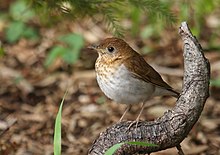Veery
| Veery | |
|---|---|
 |
|
| Scientific classification | |
| Kingdom: | Animalia |
| Phylum: | Chordata |
| Class: | Aves |
| Order: | Passeriformes |
| Family: | Turdidae |
| Genus: | Catharus |
| Species: | C. fuscescens |
| Binomial name | |
|
Catharus fuscescens (Stephens, 1817) |
|
 |
|
Veery range
Breeding range
Wintering range
|
|
| Synonyms | |
|
Hylocichla fuscescens |
|
Hylocichla fuscescens
The veery (Catharus fuscescens) is a small North American thrush species, a member of a group of closely related and similar species in the genus Catharus, also including the gray-cheeked thrush (C. minimus), Bicknell's thrush (C. bicknelli), Swainson's thrush (C. ustulatus), and Hermit thrush (C. guttatus). Alternate names for this species include Wilson's thrush (named so after Alexander Wilson) and tawny thrush. Up to six subspecies exist, which are grouped into the eastern Veery (C. fuscescens fuscescens), the western Veery or Willow Thrush (C. fuscescens salicicolus), and the Newfoundland Veery (C. fuscescens fuliginosus).
The specific name fuscescens is New Latin for "blackish", from Latin fuscus, "dark". The English name may imitate the call.
This species measures 16–19.5 cm (6.3–7.7 in) in length. Its mass is 26–39 g (0.92–1.38 oz), exceptionally up to 54 g (1.9 oz). The wingspan averages 28.5 cm (11.2 in). Each wing measures 8.9–10.4 cm (3.5–4.1 in), the bill measures 1.2–1.9 cm (0.47–0.75 in) and the tarsus is 2.7–3.25 cm (1.06–1.28 in). The veery shows the characteristic underwing stripe of Catharus thrushes. Adults are mainly light brown on the upperparts. The underparts are white; the breast is light tawny with faint brownish spots. Veeries have pink legs and a poorly defined eye ring. Birds in the eastern portions of the species' breeding range are more cinnamon on the upperparts; western birds are more olive-brown. In the east, the veery is distinguished easily by its coloration; distinguishing western veeries from other Catharus thrushes is more difficult.
This bird has a breezy, downward-spiralling, flute-like song, often given from a low and concealed perch. The most common call is a harsh, descending vee-er, which gave the bird its name. Other calls include a chuckle, a sharp and low wuck, and a slow wee-u. Veeries have been shown to decrease the rate and duration of singing when exposed to Barred owl playback, possibly to decrease the chance of predation.
...
Wikipedia

